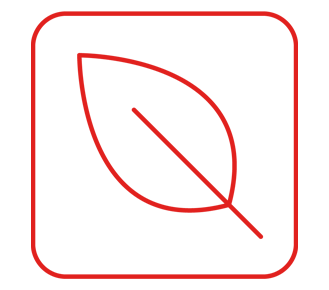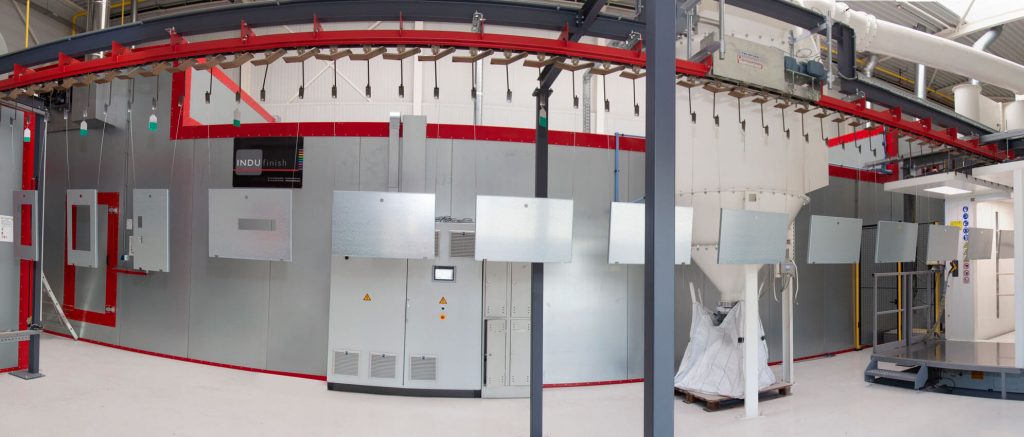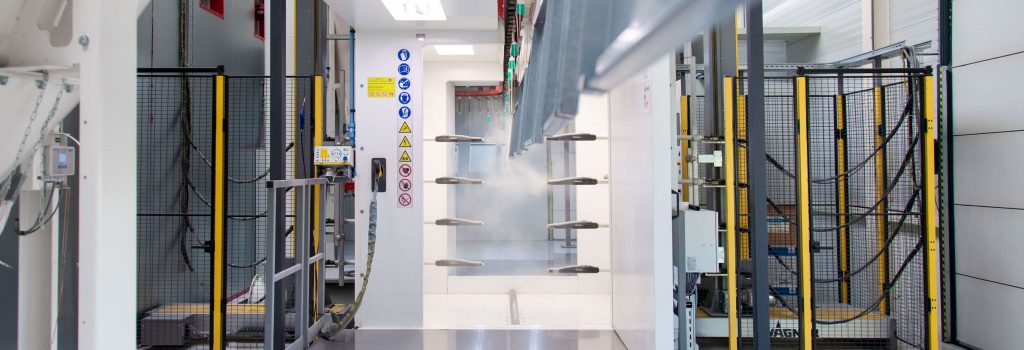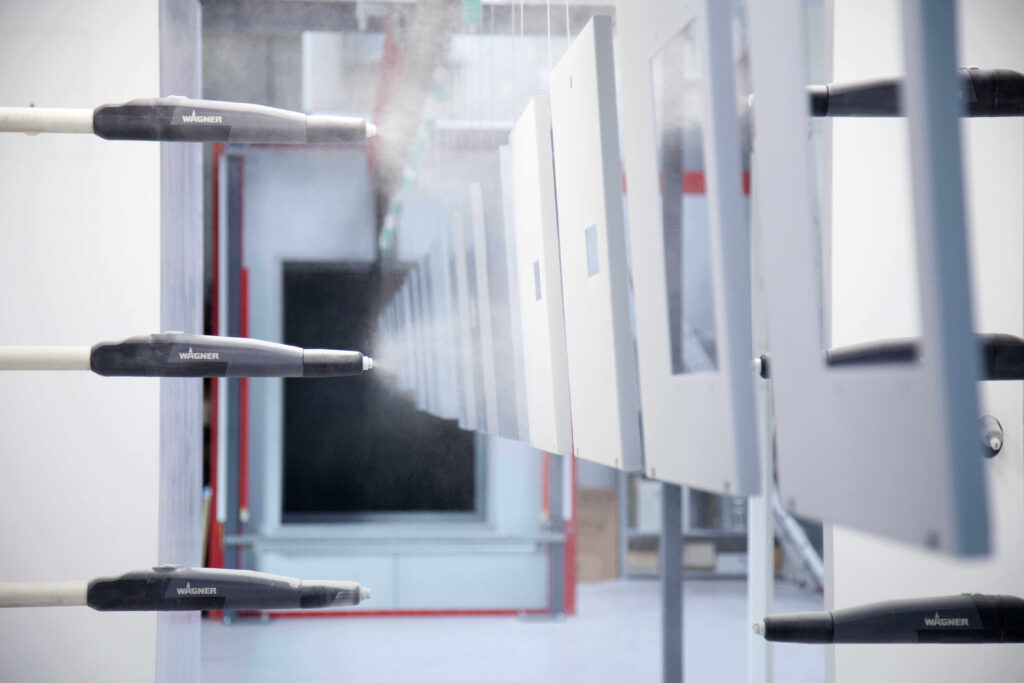Applications & markets
We all come across powder-coated products on a daily basis. Although we might not always realize it. Powder coating is a sustainable way to protect and finish surfaces.
A big advantage of powder coating is the excellent technical possibilities it offers. Powder coating can be applied to a wide range of materials and products: from parts for the automotive and machine-building industries to parts for indoor applications. Amongst other things, Dumaco specializes in the pre-treatment and powder coating of metal products. We provide the appropriate coating system for series orders and customized products. A customer’s life-span expectations, in terms of corrosion resistance and visual characteristics, are key for Dumaco.
By applying a powder-coating layer, the appearance of products changes and their life span is extended. Powder coating is used for a large number of applications and post processing techniques. Powder-coated products can be found in various environments. For example:
Characteristics of powder coating
Powder coatings are available with various functional and decorative characteristics. For example, powder coatings are available in an almost unlimited range of colors, gloss levels and metallic and textured effects, for both industrial and domestic applications.
Powder coating is mechanically very strong and has excellent UV and weather-resistant properties. Why customers opt for powder coating:
- Design: it is visually attractive and gives the product an attractive finishing touch
- Durable: because of the protection it offers against weather influences (UV) and corrosion (both of which cause wear or rust)
- Impact-resistant: because of which it protects against impact, shocks, scratches and dents
- Excellent technical possibilities: it can be applied to a wide range of materials and products and many variations are possible
- Environment: it is an environmentally-friendly way to apply paint and varnish finishes
Powder coating can be applied to almost any material: (stainless) steel, aluminum, galvanized steel and sendzimir. Products can be sprayed in almost every color: RAL colors and other colors. Different gloss effects and textures (high-gloss, satin and mat) are possible as well. We can produce pearlescent and metallic effects. The textures possible include coarse, fine and hammertone. The ultimate application (indoor or outdoor use), the material from which a product has been made and which substances and conditions it will be subject to all play an important role and determine which type of powder-coating layer is applied. For example, office furniture will require a different powder-coating layer to the one needed by a product that will be used outside and be exposed to rain, UV radiation and salt. The type of powder chosen will depend on the ultimate application:
- Epoxypolyester power: final layer for indoor use
- Epoxy powder: primer or chemically-resistant indoor use
- Polyester powder with Qualicoat class 1 qualifications: final layer for outdoor uses “UV-resistant”
- Polyester powder with Qualicoat class 2 qualifications: final layer for outdoor use “super durable”
- Acrylic powder: final layer for outdoor use
- Polyurethane powder: final layer for outdoor use “anti-graffiti”
What does powder coating involve?
Powder coating involves using an electrostatic process to paint a product, using powder as substance. The electrostatic load causes the powder to ‘stick’ to the product. Heat is then immediately used to cure the powder. This results in a ‘skin layer’ of sorts on the surface of the product. This layer is much harder than the hardness possible to achieve with conventional paint (processes).
The most important object of powder coating is to protect against external influences. The chance of corrosion, dents or scratches decreases significantly when a product has been powder coated. Products last longer and are more sustainable as a result.
Dumaco has an ultramodern coating line. It processes parts, composite parts and entire sub-assemblies. This technology enables Dumaco to supply its customers with a more complete product. This more complete product delivered reduces the number of suppliers that customers need to work with, which benefits efficiency and continuity.
Sustainability
 | Powder coating is solvent-free. |
 | There is very little waste; 90% of overspray is recovered. |
 | Powder coating is a very sustainable surface treatment and also an excellent, anti-corrosion solution. |
 | Powder coating is an economic and environmentally-friendly coating technology. The powder-coating process generates a minimum amount of waste. |
Powder coating: the process
Dumaco prides itself on its far-reaching integration into its customers’ chain. Its powder-coating service is making the range of services it is able to provide even more complete. Powder coating is one of the last steps in the processing of a product. With a powder coat layer as a finish and the possibility of assembly too, Dumaco is able to relieve customers of a substantial part of the production process.
Our powder-coating line covers the entire process. It starts with the manual suspension of the products to be coated. They then move through the cleaning tunnel, pass through a drying oven, are sprayed with electrostatic powder and disappear into the muffle furnace, where the chemical reaction – melting, cross-linking and curing – happens. Afterwards, the products are ready to be removed from the line, possibly then to be installed, packaged and dispatched.
The most important advantages of powder coating:
- Time saving: post processing possible immediately due to the rapid reaction of the product in the oven.
- Healthy: no solvents and no release of unhealthy gases. This is because the paint is a solid substance and no chemical additives are necessary.
- Environmentally friendly: no ‘waste’ because all the particles adhere, the powder that doesn’t bond can be re-used and re-sprayed after filtering. Also, as already described above, no environmentally-harmful solvents are added.
- High-quality and sustainable: the paint is often harder than ‘ordinary’ paint and lasts longer.
The process in three steps
1. Pretreatment: the cleaning process
The quality of the end product depends on the pretreatment. The first step in the powder-coating process is to clean the part or product with chemicals. For environmental reasons, the bath is heated with clean energy obtained from solar collectors. After the bath, the product is clean and grease-free. A conversion layer is then applied, which allows the powder to adhere better. The product will need to pass through a drying oven before the powder can be applied.
2. The powder-coating process
Once the product is completely clean and dry, compressed air will be used to apply negatively-charged powder to the grounded, positively-charged product. During this process, a spray gun is used to spray the powder particles onto the surface. When leaving the spray gun, the particles are electrostatically charged. This causes them to adhere to the surface of the product.
3. Drying and curing
The sprayed parts then enter a muffle furnace straight away. The temperature of the oven will depend on the thickness of the material, the speed of the powered conveyor belt and the type of powder. The powder particles melt and spread evenly across the surface. A chemical reaction then takes place and causes the paint to harden into a very strong protective layer.




 Standard quotations are always issued within 24 hours
Standard quotations are always issued within 24 hours



